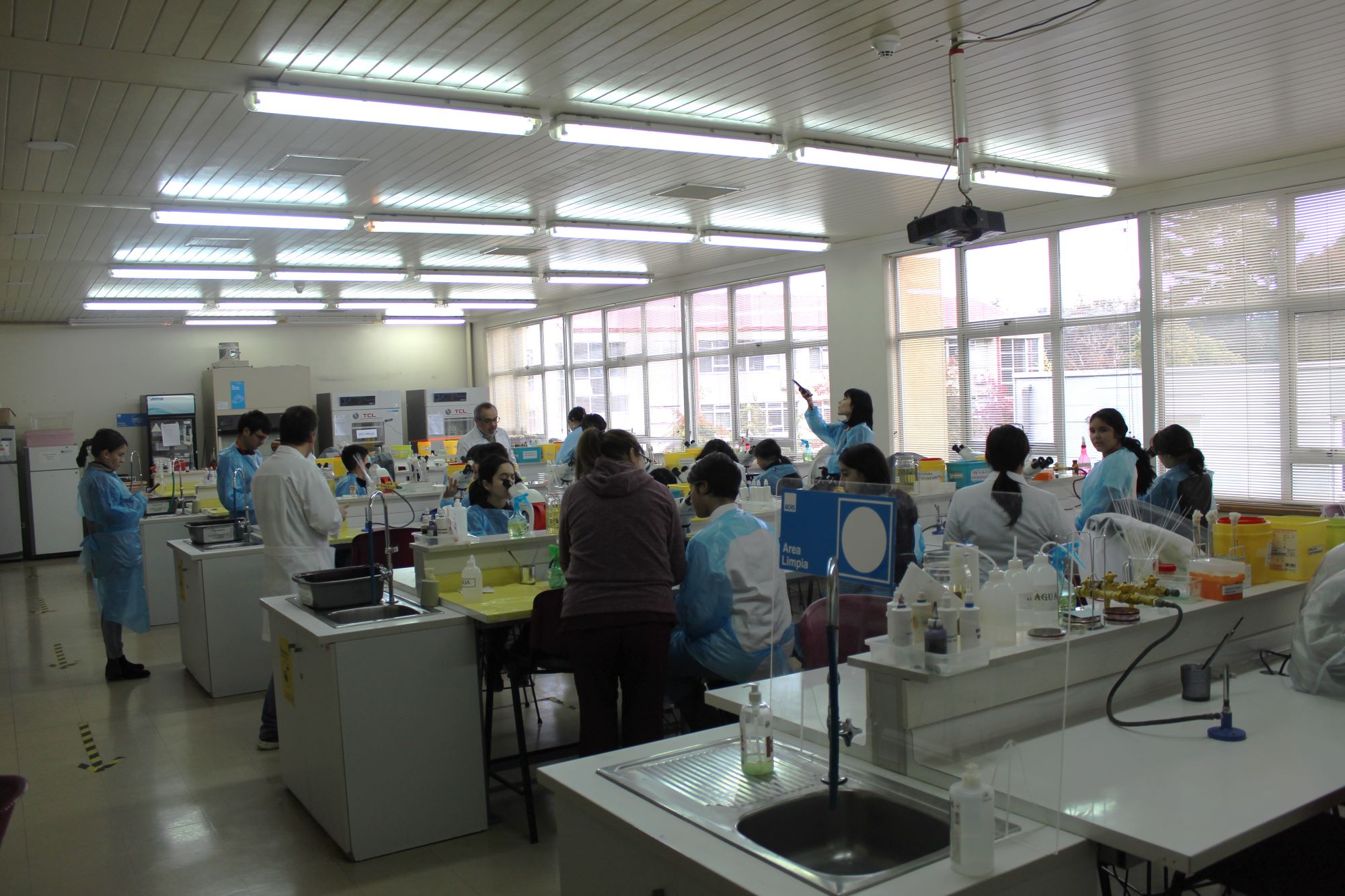The “Microuniverses” laboratory is proposed as an interdisciplinary experience that unites science and art, by exploring the fascinating world of microorganisms, experimenting with cultures of fungi, bacteria and microscopic organisms as a basis for the literary creation of small stories, with visualization techniques beyond the use of a microscope, including visual information processing strategies. And creating narratives from the results, to make visible what is difficult to observe with the naked eye.
For this reason, boys, girls and young men visited the Clinical Microbiology Laboratory of the Faculty of Medicine of the UACh, where they carried out microscopic and macroscopic descriptions of fungi and bacteria with UACh teachers and the CECREA team.
“Using a microscope they observed the different structures of the fungi, the morphology and Gram staining of the bacteria. The macroscopic description consisted of observing and recording the properties of the microorganisms in the culture medium, i.e. the size of the bacterial colonies, the type of mycelium, the color, among others. In the end, each participant cultivated His favorite bacteria in two culture media,” explained academic Mario Gonzalez from the Institute of Clinical Microbiology.
Strategic alliance
Regarding the work carried out with children and young people, teachers from the Institute of Clinical Microbiology who supported the activity highlighted the enthusiasm and learning achieved.
In this sense, Director of the Institute of Clinical and Academic Microbiology, María Paz Villanueva, highlighted that “the activity was very well received by boys, girls and young people, who were excited and anticipating learning about the world of microorganisms. The children had the opportunity to explore and learn about both bacteria and fungi, and to relate these organisms.” In addition to actively participating in the practical activities prepared by our institute, they have the opportunity to carry out their own microbiological experiments. For us as teachers, it is an opportunity to open the doors of the Institute of Clinical Microbiology to the school community and promote interest in science.
For her part, academic Fadwa Latif added, “In general, the children seemed happy and enthusiastic about the activities being carried out in the laboratory, whether in the concentrated fields or in the cultivation activities that they carried out themselves. I highlight their ability to start a conversation among themselves, because they are from different schools, And with us, as well as their ability to follow instructions.
He added: “What seems most important to me is giving children the opportunity to learn about the laboratory and management in it and be able to visualize different types of microorganisms. Many of them commented that they had been told about bacteria and fungi at school, so being able to visualize them and work with them ensured learning. On the other hand, for us as teachers, who always work under standardized and controlled conditions, it is interesting to observe how children behave, interpret and process information differently.
Likewise, academic Patricio Godoy commented on this “The children’s reception of the activity was very good. We saw their curiosity when they were in front of the microscope, as they were able to see both bacteria and fungi, which are microorganisms that are invisible to the human eye. When they were able to see and observe them, these reactions on their faces are a source of joy for us as teachers. The importance of the activity is that it opens a new door of knowledge, which is the microscopic world. For us, it is very comfortable to do this type of activity, as we receive important information from them when describing in their own words and comparing the shapes of bacteria and fungi with objects from their daily lives.
Meanwhile, on behalf of CECREA Los Ríos, Christopher Quintol, Science Coordinator at CECREA, expressed his appreciation for the alliance between the entities and commented: “This alliance between the Institute of Clinical Microbiology and CECREA Valdivia allows us to significantly expand our programmatic capabilities and converge science. With Other disciplines such as art, which provide rich experiences for girls, boys and young people and this helps us to better understand how we relate to the different microorganisms we live with. For example, many participants often linked microorganisms to diseases and infections The case enables us to know that it also plays an important role in the production of foods such as bread and the acquisition of medicines such as penicillin. Moreover, the convergence, which is a fundamental pillar of CECREA's activities, with the arts, allows us to reinterpret the reality that surrounds us and the progress of microscopic fungi and bacteria A variety of shapes and colors, which stimulates the creative element in childhood and allows us to imagine wonderful worlds with countless stories that we hope to capture in a collective book that can be disseminated in the community, thus enhancing self-esteem. Science and art among members of our society.”
expertise
Josefa Echeverría, a 12-year-old lab participant, highlighted the experience by saying, “My favorite part of the lab was meeting new friends, and even discovering new things I didn’t know about biology. It was being able to visit the Austral University laboratories.” “It's really cool because I've never been there before and it's so beautiful.” “The thing that caught my eye the most were the little ones, because I think they're the smallest.”
The final session was held at the end of April and was an opportunity in which children and young people reviewed the culture media grown, observed the culture technique used in the media, and performed a Gram stain which will allow them to sort bacteria to the gram. Gram positive or negative. Based on the results obtained and recorded in images, we will advance towards the final stage of this laboratory, where mini-stories will be created based on the imagination of each participant.
The ultimate goal is to compile a book that includes photographs of the sessions, the crops grown by the participants, and the stories associated with them.







